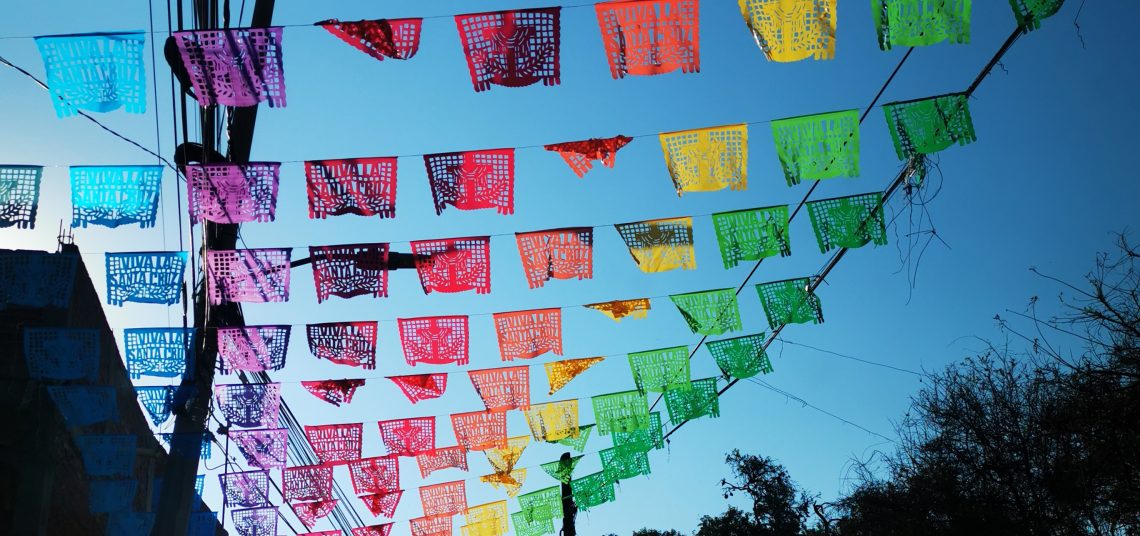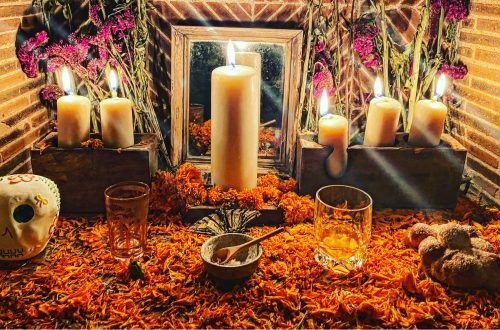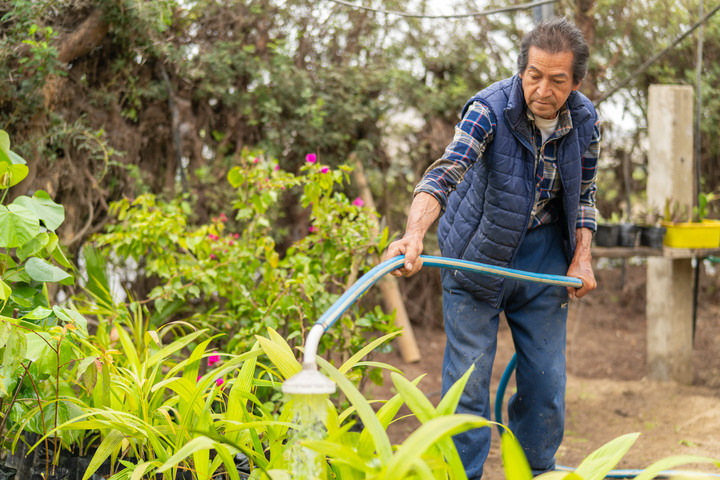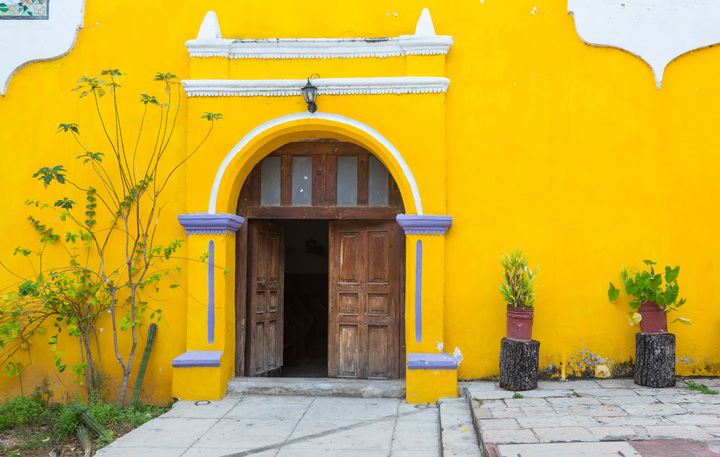I don’t deny the advantages of the Ajijics and San Miguel de Allendes and Puerto Vallartas of Mexico.
Believe me, as someone who arrived here 20 years ago with two small children, I get how helpful it is to have a Walmart and a Home Depot close at hand.
And how comforting it is to have a built-in community of fellow expats, especially on those days when some trivial task – like paying your CFE bill or finding a plumber – has been particularly daunting.
I also get that it’s exhausting to speak or try to speak Spanish all day.
But I say, give it a try, take a chance. It is definitely worth stepping off the beaten path.
When we arrived here in Colima 20 years ago, we couldn’t even find a map of the city, let alone peanut butter or Hershey’s Cocoa.
That’s all changed now, but the Pueblo Mágico where we eventually bought property and built a house is still enchanting. ..in ways that none of those expat “havens” are.
Within a 20-minute drive, we now have three malls, two movie theaters, two good hospitals, not to mention three Starbucks, three Walmarts, one Home Depot, one Office Depot…the list goes on.
Many of the Mexicans I know like to practice their English on me (or ask me for lessons), have travelled abroad, sent their kids to private schools (often with our kids, so we have a huge network of parents).
But where we actually live, most people don’t have cars, and some have dirt floors or at least adobe walls.
Lots of people still regularly ride down the street on horseback or muleback.
Chickens and hens regularly refuse to get out of the way of our Prius, since it only makes a spaceship sound and they don’t believe it’s a car.
The milk pick-up truck goes by every day, and we sometimes get stuck behind it as they pour the fresh creamy milk that is sloshing in big white paint buckets into those aluminum milk cans and deliver them to people’s doorsteps.
Every Saturday, Javier brings berries to our doorstep – blueberries, raspberries, strawberries, blackberries, cherries – at a fraction of the cost of Walmart (and takes our thousands of empty berry cartons to reuse).
On Sunday, Paloma comes by with her bucket of flowers, and we buy lavishly because they are cheap and beautiful.
We finally installed a water purifier under our kitchen sink, but for years Ulises brought us garrafones of water a couple of times a week in his battered blue pick-up truck, and pre-COVID would lug them in and flip one upside down onto our clay garrafón holder for me.
And we know Ulises’ wife and children, because they’ve come to our craft sessions in the nearby parks over the years, and to our blow-out Halloween parties.
Regularly, young waitstaff or salespeople in stores or new moms proudly pushing babies in strollers stop me to say hi.
I sometimes struggle to place them, but that’s just because they’ve grown – we met in the classes we’ve taught on how to make crepes, or how to start a business.
Or they participated in our Science Fairs, or hammered, sawed, nailed, glued and painted bookcases for their libraries with us. Or they’ve worked at our Halloween parties.
Or sold us limes, tomatoes, cucumbers and jicamas.
Or they’ve dropped off boxes of kittens or bags of puppies who were going to be drowned otherwise.
Or sold us raffle tickets, including one memorable time for a lamb because they couldn’t pay their electric bill. The three young boys assured me I would “win,” and so I did.
Lambs by the way are very noisy and drink a staggering amount of milk, two liters a day.
We took possession but you could hear the little thing two blocks away.
After a grueling afternoon trying to feed and pacify her, we put her in the back of our mini-van, I put $500 in an envelope, and we took her back to her (human) family.
They were in tears, as she had been bottle-fed since she was born, and they were all delighted to be reunited. We were delighted to have dodged a bullet.
I don’t think you win a lot of lambs in home-made raffles in Ajijic, SMA or PV. Maybe I’m wrong.
If that doesn’t convince you, though, our house – or your house, as they say here – is on a small coffee orchard, with about a hundred Arabica trees.
A small creek runs along the bottom of our property, and the whole thing is shaded by an enormous parota tree, home to squirrels and iguanas and gigantic ants and sadly some termites.
We also have all kinds of birds – several varieties of hummingbirds, red-headed woodpeckers, Mexican cuckoos, bright green parrots, calandrias (orioles), kingfishers, the occasional hawk.
And of course, our very own vulture, Vultura.
She regularly circles our property, keeping us safe from all the yucky stuff her highly acid stomach lets her digest with impunity, but which would kill us in a hot second.
For what we paid for the land – even though at the time the dollar was at M$11 – and to build our house, we probably couldn’t have bought a cochera in any of the expat “havens.”
Here, properties are priced in pesos, not in USD or CAD.
And yes, prices have gone up everywhere, but there are still lots of opportunities, and your buck goes a lot farther here.
We definitely don’t have a big range of exotic foreign restaurants – which I will admit I miss.
But we do have one Thai restaurant, and one Chinese restaurant, and a bunch of the Mexican version of Japanese restaurants. And a couple of excellent Italian restaurants.
Most of all, though, we have delicious Mexican food.
I’d pit our local taco stand against the finest taco restaurants in the whole world.
And yes, gentrification has arrived to our little town, and we have a very fancy restaurant/hotel that serves (very expensive) veal tacos with Aperol spritz, but in a spectacularly beautiful garden – an old mamey orchard – with a lovely pool that shimmers magically in the warm nights.
And weather is another thing.
When I go to Ajijic and San Miguel de Allende, I freeze to death.
Maybe it’s just that I’m less young, but I’m like a lizard nowadays. I like it warmer. Here the average temperature is 86°F (30°C), and the average low is about 66°F (19°C), but only at night, so we sleep well except for on the hotter nights in May and June.
I’m not saying everyone should move here – we are on the State Department’s No-Fly list, because of violence.
And it’s there – we see all the soldiers and National Guard trucks bustling about. And we’ve known people who were affected.
The husband of the daughter of the woman who cleans our house was a policeman and was shot in his car. Another young policeman was shot in our town square, in front of his wife and baby and other onlookers, when he was visiting his mother.
For as long as we’ve lived here, she has been selling the bread our town is famous for on a folding table by one of the fountains. And we hear that warring gangs regularly take each other out, with the occasional stray bullet striking a bystander.
But that violence is probably even worse in the bigger cities. Not to mention Chicago, where we came from originally.
So, if you’re feeling adventurous, or even just curious, why not step outside of the expat bubbles and explore the real Mexico?
It may exasperate you, frustrate you, confuse you, and you might even end up with a lamb.
But it may be one of the coolest experiences of your life.
What Should You Evaluate Before Moving to a Mexican Pueblo?
To thrive in a small Mexican pueblo, make sure you do your homework.
If possible, have at least a grounding in Spanish.
Then check out the local culture, assess infrastructure, investigate the economic realities and employment situation if that applies, and research safety and climate (all year round, not just when you visit).
Most important, though, prepare to embrace a slower pace of life and your pueblo’s unique traditions – relax and enjoy the show!
Culture & Community
#1 Language
Learning Spanish is crucial for daily life, forming connections, and fully integrating into the community.
But you don’t have to master everything, just a few key phrases.
Lots of Mexicans will want to practice their English with you, so take advantage and practice your Spanish with them.
#2 Local Customs
Research local traditions, festivals, and social norms to understand and respect the established way of life of your pueblo.
I have often heard expats complaining about fireworks, church bells, and noisy parties that run all night.
If noise bothers you, perhaps invest in earplugs or noise-cancelling headphones. Or join the fun!
There are fairs and festivals almost every month here, to eat bread and chocolate, drink homemade alcoholic punch or mezcal, buy artesanias, listen to mariachis or watch the parades of kids, Apache dancers, women on horseback, men on horseback, or floats of musicians inch past you as you sit in the main square, sipping atole and enjoying tamales, or eating a guayaba or guanabana paleta quickly before it melts in the sun.
#3 Community Integration
Make an effort to meet and connect with your neighbors and other community members to build a strong social support network. A lot of neighborhoods have neighborhood watch groups, but just hanging out in the square or striking up conversations at your local abarrotes store works too.
#4 Pace of Life
Be prepared for a slower, much more relaxed pace than you may be used to and keep reminding yourself that this is one of the reasons you moved to Mexico.
I am a very Type-A person and spent my first years here tapping the floor impatiently as I waited in the bank line, or to pay my license plate fees, sighing dramatically and rolling my eyes.
Everyone politely looked away, and I finally got the message.
The problem wasn’t that the teller or the clerk weren’t moving fast enough, or that the very old woman in front of me was deaf, but rather that I’d somehow come to believe my needs were the most important in the room.
Humbling but in the end, much more relaxing.
Infrastructure & Practicalities
#1 Healthcare
Even if you aren’t as old as I am, investigate the availability and quality of healthcare services and facilities in your pueblo or the nearby towns.
- How well stocked is the Centro de Salud?
- Is there a defibrillator in town (our town only got one a couple of years ago)?
- How far away is the nearest Level 1 or Level 2 trauma center?
- Is there a private hospital? A public one?
Maybe do some discreet site visits. The Mexican health system does not work the way it does in many other countries, and railing against the differences will only age you. Trust me, I know.
#2 Health Insurance
Unless you’ve already gotten your naturalization, (according to the Mexican constitution every Mexican citizen is entitled to cost-free access to healthcare and medication), make sure you have health insurance.
Healthcare is a lot less expensive than in some other countries, but you never know.
You can buy a policy through a private insurer, or if you are a resident you can enroll in IMSS (Instituto Mexicano del Seguro Social, the Mexican Institute of Social Security).
IMSS is Mexico’s governmental social security system that provides healthcare and other social benefits to payroll employees, their families, and other voluntary participants, funded by employer, employee, and government contributions.
It’s a story for a different time, but you can register as an independent worker (persona trabajador independiente) and get very affordable IMSS healthcare coverage that way.
#3 Utilities
Investigate the reliability of services such as water, electricity, and internet access, as these vary significantly, especially in smaller towns.
For example, in the larger city of Colima, we were charged for the water we used (which could be quite expensive), where here in our pueblo there are still no meters, we just pay a flat (very modest) fee every year.
And we learned the hard way that if your electrical usage is too high, you stop receiving the government subsidy and can get hammered (as we did, when we had a short circuit where we plugged in our washing machine).
Also, we didn’t get fiber optic cable in our town until years after they had it in the larger neighboring city of Colima, and had to limp along with very slow speeds until Telmex and Megacable finally bit the bullet.
#4 Transportation
Even if you have a car, check into the local transportation options, including public transport, and taxis (in case your car needs work done, or won’t start, or your cochera is blocked by a huge driverless truck that you can’t push out of the way).
See how easy it is to get around the pueblo and to nearby areas, especially if you have health or mobility issues.
Not all of Mexico is special-needs-friendly.
Our town has installed ramps on a lot of sidewalk corners, but the sidewalks themselves are often quite chewed up, or have stairs going into the middle of them, or trees or tree roots that have raised the cement in jagged fragments, so I have no idea how someone in a wheelchair could go more than a block or so without hitting an obstacle.
#4 Car Insurance
Mexican law requires that any car driving on federal roads and bridges, including those with U.S. or Canadian plates, carry liability insurance from a Mexican insurer.
A foreign policy, even with a Mexico endorsement, is not recognized by Mexican authorities for liability coverage.
Economics & Lifestyle
#1 Cost of Living
Investigate the average cost of living in your pueblo, including groceries, housing, and local services, to make sure your budget aligns with the local economy.
In the current market, prices are going up, even in our little town (according to the central Bank of Mexico, inflation is around 3.5% but it feels like more).
And especially if you’ll be eating out a lot, or building a house, or driving a non-hybrid car.
A good way to figure out what regions in Mexico are less expensive in terms of cost of living is to compare what is called the canasta basica, a representative sample of 24 foods that fill the basic requirements of an imaginary Mexican. It tracks by region and even by supermarket chain the cost of this basic basket of foods for one person.
It wouldn’t cover arugula, or cheddar cheese, or root beer, but the comparisons are valid.
Forbes produced a helpful map showing the relative costs of a “vida digna” – a decent wage – in different regions, with an average of $16,421 pesos per month to cover basic expenses:
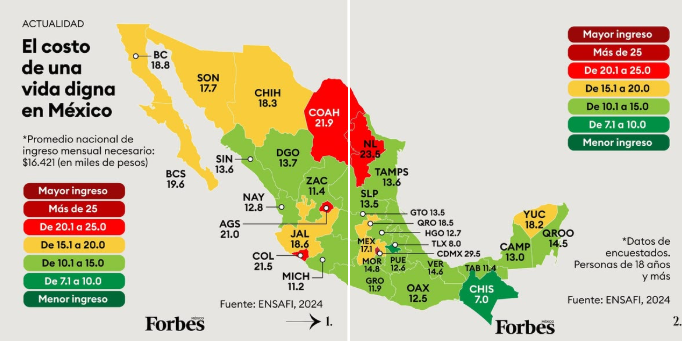
#2 Employment
If you need to work, as I still do, research local employment opportunities.
The pay is definitely not great but if your immigration status allows it, there are plenty of jobs for expats, especially anglophones.
Then of course, there are always remote work possibilities, preferably where your employer is in a country where the pay scale is higher – if you can manage to earn in US dollars at US income levels, and live at peso levels, you’re really in the money.
#3 Activities & Hobbies
Have fun exploring local activities, hobbies, and recreational opportunities in your pueblo, from outdoor adventures to cultural events. In our little town, with very little searching, you will find classes in pottery, painting, all kinds of dance, English, Spanish, French, German, and many musical instruments (we even have music schools, as being a musician is seen as a solid career choice here in the land of the mariachi).
You can hike up our volcano – take your pick of the active one (much hotter) or the dormant one (lovely and green up to the tree line), kayak in a volcanic lake, hang glide or fly an ultralight through our breathtaking valleys, ride horseback, climb pyramids, swim in the ocean (from surf-worthy breakers even Australians come to visit to long gentle inclines safe for toddlers) and then drive an hour and toast marshmallows over a fire pit in a mountain cabin surrounded by pine trees, wearing a light sweater and a tired grin.
Or we can hop in the car and be in Ajijic in three hours, meeting other expats at the Lake Chapala Society and listening to jazz, or gorging at gourmet-level restaurants. Even if you are so inclined, you can’t be bored!
Environment
#1 Climate
Research the climate and weather patterns of your prospective pueblo carefully – and check year-round statistics – including typical temperatures and rainfall, to make sure local conditions suit you.
When we first moved here, we lived in the city of Colima.
Within about six months, we realized we wanted to move here, but not here here, it was just too hot.
So we looked up – literally – up the skirt of our active Volcan de Fuego volcano.
It is (ironically, perhaps) cooler as you go up, since the change in temperature, the “lapse rate”, is 6.5°C (or about 3.5°F) per 1,000 meters (3,281 feet).
Where we settled is several degrees cooler than where we started.
I’d like to say we chose the site very carefully but in fact, we were just incredibly lucky – our property is on a little stream, with a small coffee orchard (and a bunch of other types of fruit trees we hadn’t even heard of), shaded by an enormous parota tree.
And we insisted that our architect build our ceilings to 3.3 meters high, so every room stays cool and gets a lovely breeze almost all the time, while facing a (small) valley of leafy greens in all shades – parotas, primaveras, rosa moradas, higueras, a majagua, bananas, an ebony we planted before we’d signed on to the whole native-plant thing.
And no matter what, make sure there’s water all year long. And that it doesn’t get too hot or too cold (unless you like that….!?).
#2Natural Environment:
Make sure the local geography and natural features in and around your pueblo, such as mountains, beaches, or cenotes, match your dreams. Huge swathes of central Mexico are on the altiplano or meseta central – high plains, central plateau – including Mexico City with cooler temperatures, and drier, thinner air.
The coasts frame this with two long rugged mountain ranges – the Sierra Madre Occidental (the western range along the Pacific) and Oriental (the eastern range along the Gulf)).
The long Pacific coastline, and around the boot of Yucatan and Quintana Roo, boast breathtaking beaches, some clogged with tourists but many still remarkably untouched.
In the north there are vast deserts, and in the south and east, tropical rainforests and jungles.
Cutting the country in half is the Trans-Mexico Volcanic Belt, a chain of high, active volcanoes across central Mexico where most of the population resides (including us and Mexico City).
What would work best for you?
